Motorhome towbars and towing
Whether you want to fit a bike rack or rear storage or tow a car behind a motorhome, towbars are fairly versatile accessories for motorhomes and campervans.
Page contents
- Can I fit a towbar to my motorhome?
- Can I tow a trailer with my motorhome?
- What weight can I tow with my motorhome?
- Can I DIY fit a towbar?
- What type of towbar is best?
- What weight can my towbar carry?
- Do I need towing training?
- How do I tow with a motorhome?
- What motorhome trailer should I buy?
- How do I maintain my trailer?
- Can I tow on an A-frame?
- What speed can I do when towing a trailer?
- What accessories do I need for towing with a motorhome?
- About our magazines
Can I fit a towbar to my motorhome?
Most motorhomes can have a towbar fitted, but the type of towbar needed depends on when your motorhome was built:
- Before April 2012 (61-plate or older): almost any type of towbar can be fitted.
- After April 2012 (12-plate reg or newer): it must be fitted with a type-approved towbar for all towing applications, but a non-approved towbar can be used to support a rack for a bicycle, motorcycle or scooter. Though, we would always recommend a type-approved version in case you decide to sell and a future owner wants to tow a trailer.
However, some motorhomes with a large rear overhang and no rear chassis support framework may not be suitable for adding a towbar. In such cases, you may be able to have additional chassis bracing which can be welded or bolted in, but this isn’t always the case as it depends on the available payload.
So, with any vehicle that you’re considering having a towbar fitted to, your first port of call needs to be to your local towbar specialist or motorhome dealer to see what can actually be fitted to your vehicle.
Can I tow a trailer with my motorhome?
This is all to do with driving licences... you’ll need BE on your licence to be able to tow an average trailer. If you passed your test:
- Before 1 January, 1997, you’re usually allowed to drive a vehicle and trailer combination up to 8,250kg maximum authorised mass (MAM)
- After 1 January, 1997, you can now tow a trailer up to 3,500kg. This rule came into effect on 16 December, 2021. Before this point, most drivers passing their test from 1997 onwards had further restrictions on towing.
The new rules that came into effect in 2021 basically grant all car drivers the BE licence. However, the rules for those passing their test before 1997 have not changed and that 8,250kg limit still applies.
Car drivers do not need to do anything, the DVLA will make these changes automatically. Photocards will be updated as and when required (at renewal time or a change of address, for example). Find out all the details on the Government website here
What weight can I tow with my motorhome?
Just because you can legally tow and your motorhome has a towbar, it does not mean your actual motorhome can tow your intended trailer or car.
The weight your vehicle can tow is determined by the motorhome manufacturer. It is typically around 2,000kg, but that’s not always the case.
Look for the Gross Train Weight figure on your weight plate – and always refer to the end manufacturer’s plate (Swift or Hymer, for example). The original Fiat base, or any third-party chassis manufacturer may have more towing capacity than a coachbuilt motorhome once the body and furniture has been added.
Can I DIY-fit a towbar?
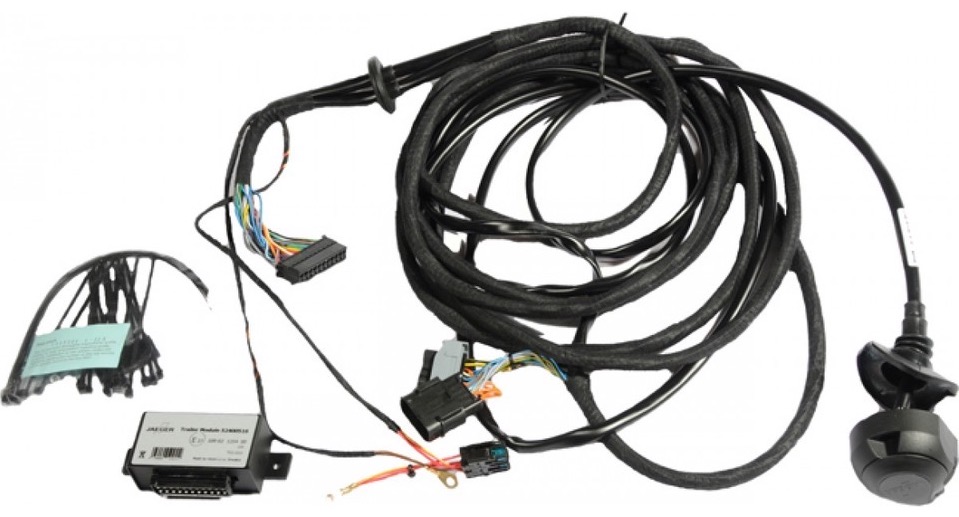
(Photo courtesy of LNB towbars)
Don’t DIY-fit towbars, not only are they massively heavy bits of kit, but their steel framework makes them even heavier and they’re often a two-man lift. Equally, modern wiring looms can be very complex and are not something that should be tackled on a DIY basis.
If your manufacturer offers a factory-fitted towbar option, always go for that – it will best integrate with the vehicle and will be type-approved. If you already own the vehicle, then speak to your motorhome dealer and see which installers it recommends.
Opt for a dedicated vehicle-specific wiring loom if available – it will cost more, but it will be far more reliable in the long run. It will also often be quicker to install, saving labour time.
What type of towbar is best?
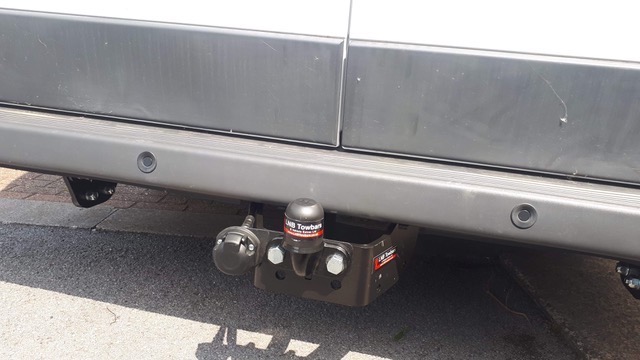
(Photo courtesy of LNB Towbars)
A regular two-bolt towball is the most common type of towbar and is the best option for most motorhomes as there are so many bike racks and storage boxes that can be attached to them.
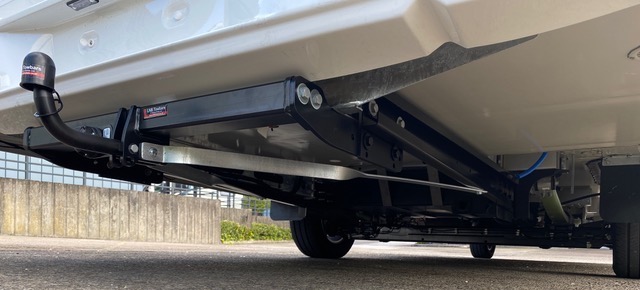
(Photo courtesy of LNB Towbars)
There are also swan neck types that curve neatly up from the back panel.
You can also get detachable types where the tow hitch can be removed when not in use – it’s neater, but more expensive and needs more maintenance.
What weight can my towbar carry?
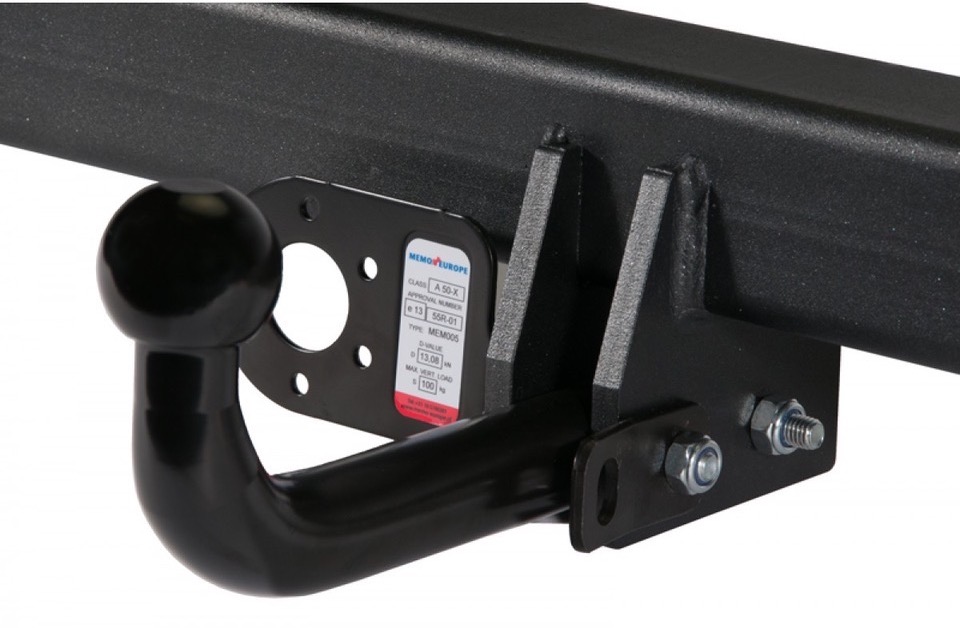
(Photo courtesy of LNB Towbars)
Whether you want a rack or a trailer, it is always subject to the noseweight limit of the towbar and framing. The noseweight is the vertical load exerted downwards on the towball. This is defined by either the towbar manufacturer or the motorhome maker; you always have to use the lowest figure. It is typically between 100kg and 150kg for a motorhome, but it could be lower on some smaller campervans.
A bike rack will weigh 20kg and have a maximum weight limit of 60kg, which is usually ample for a couple of e-bikes, but you also have to factor in the number plate and any extra straps, chains or locks you’ve added. If you only have a low noseweight of 80kg, it’s easy to exceed it.
Watch your payload. Whatever is loaded on a rack – together with the weight of the towbar assembly itself – must be subtracted from your available payload. Some motorhomes may have an issue – the longer the rear overhang, the greater the cantilever effect on the rear axle.
With a trailer you’ll need to use a noseweight gauge to weigh the vertical load pressing down on the towball by the trailer hitch. These are available online for around £30. Noseweight is less of an issue, because you can easily move the load around on the trailer so that it exerts less downward force on the hitch. This can be done by moving kit around in a box trailer, moving a vehicle rearwards on the trailer, or simply removing some kit from the front of the trailer.
If the load isn’t balanced the trailer will dip down heavily at the front or the motorhome’s rear suspension will be heavily compressed. If moving the trailer’s weight around doesn’t alter this, the rear suspension of your motorhome may need looking at – it could have worn rear springs. You can also have additional airbag rear suspension fitted to better cope with towing and this is an upgrade that works well on most motorhomes.
Do I need towing training?
While you might be licensed to tow a trailer, that doesn’t mean it’s wise to hitch up and have ago. Get some independent training before you head out on the highway.
Various firms offer professional tuition with prices from around £200 per day – companies offering courses are dotted around the country so Google your nearest.
How do I tow with a motorhome?
The additional length of the trailer and the wider turning radius have to be considered when turning – watch your mirrors and allow plenty of room for obstacles and undercutting cyclists.
Watch out for the trailer ‘wagging’ its tail when manoeuvring between parked cars on busy streets and remember that the additional weight will extend braking distances.
If the trailer doesn’t feel stable, stop where it is safe to do so and check it. Ask the following questions and sort any issues before continuing:
- Are the tyres fully inflated?
- Have any securing straps come loose?
- Is the trailer loaded evenly?
Unlike cars towing caravans, motorhomes are rarely troubled by the trailer ‘wagging the dog’. However, taller box trailers need to be driven with care and you need to be mindful of crosswinds – especially when passing trucks or driving over bridges. With all trailers, don’t change direction violently at speed – always change lanes smoothly to avoid upsetting the load.
The shorter the trailer, the harder it is to reverse, and small box trailers are incredibly easy to jackknife in reverse and damage the rear panel of the motorhome. Reversing sensors don’t work with trailers – some modern vehicles have a defeat switch to avoid this irritance, but many do not.
Never unhitch a car trailer with the vehicle on it – you won’t be able to move it - and, with empty twin-axle models, it’s best to wind the jockey wheel until the leading axle’s wheels come off the ground as it will be easier to move and turn it around by hand.
What motorhome trailer should I buy?
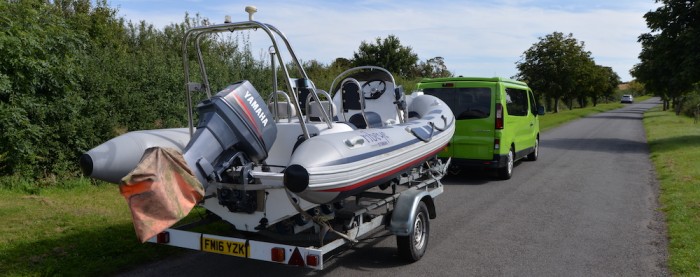
(Photo courtesy of Peter Rosenthal)
The most common types for motorhomers are the all-purpose box trailer and vehicle trailers.
Box trailers come in all shapes and sizes, but look at the wheel size. For local trips, small wheeled box trailers are fine, but for longer journeys or more extensive European trips, they can be troublesome. Smaller wheels rotate faster and tend to have more issues with bearing and tyre wear. We recommend wheels above 12in diameter. Always carry a spare wheel for the trailer (ideally covered to reduce UV damage) and check the pressures regularly.
Motorbike and car trailers tend to be fitted with more durable wheels as standard and come in all shapes and sizes. Make sure the trailer has a load rating suitable for the vehicle you’re carrying and is sized to suit it and no larger than you need. The higher the weight limit of a trailer, the heavier and more cumbersome it will be. Twin-axle trailers are better for towing a medium-sized car (such as a VW Golf) as they’re far more stable, but for smaller cars (like a Smart car) a single-axle model works fine.
The loading process is important. Some car trailers use long ramps to load vehicles and these can be heavy to manhandle and require a lot of dexterity and strength. Tilt-bed trailers, or those fitted with a fold-down loading ramp are easier to load.
The securing straps make a big difference to the ease of use. With motorbikes, buy dedicated straps that go around the handlebars and then pull tight – look for straps that do not use hooks directly on the bars, but have a nylon loop that goes over them. Straps for cars tend to all fit around the tyres and are best used on all four wheels. Look for those that have no metal D-rings around the wheels as these can flap around and damage the paintwork on alloys. Some trailers – such as Brian James ones – have the straps built into the trailer and these can make loading faster.
How do I maintain my trailer?
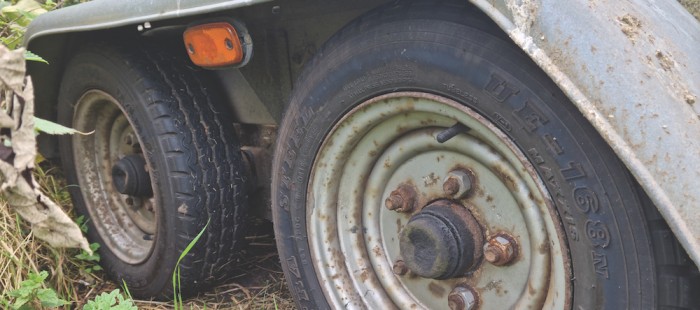
(Photo courtesy of Peter Rosenthal)
- Check the tyre pressures before every trip and make sure that you replace tyres at the first signs of cracking on the sidewall. Tyres must have a minimum tread depth of 1.6mm across three-quarters of the tread width. However, the National Trailer and Towing Association points out that anything below 3mm of tread depth massively increases skid risk on wet roads. Consider replacing trailer tyres every five years or so, especially if they’re stored outside and subject to constant UV and flat spotting damage. Smaller tyred trailers tend to need the most maintenance for the simple reason that, at 60mph, they’re rotating faster.
- Wheel bearings: If the hub gets hot, either the bearings have failed or need regreasing and the brakes may need looking at. Any boat trailer that goes in the sea for launching will need regular maintenance to avoid issues (saltwater always gets into the bearings even if they’re sealed).
- When you first hitch up, check all brakes are free; they often seize on in storage. If your trailer has a handbrake, it’s best to only apply it on the road or when you have to – in storage these can seize on. If any brakes do seize, tapping the wheel rim with a soft-faced hammer can often free them up. Most braked trailers use drum brakes which are pretty easy to adjust and replace, but it’s a messy job that most people wisely entrust to their local trailer specialist
- It’s wise to get car trailers or any other larger trailers serviced annually.
- Check the straps carefully for cuts and tears and replace them when they show signs of fraying. Buy vehicle securing straps from a UK-based retailer to ensure that they are definitely UK-tested for their maximum weight limit (anything supplied direct from abroad can circumvent CE testing and should not be relied on).
- Carry a suitably sized socket set to remove the wheel nuts and also check that your vehicle jack fits the trailer – most trailers are not supplied with wheel-changing kit.
Can I tow on an A-frame?
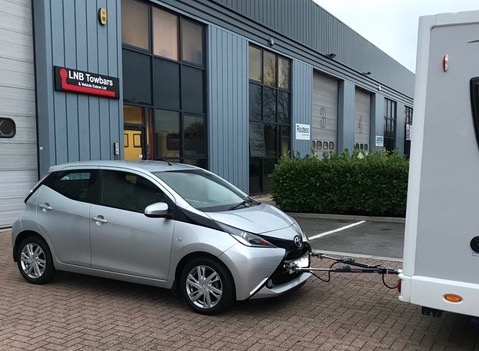
(Photo courtesy of LNB Towbars)
An A-frame can be temporarily attached to the front structure of a car to allow it to be towed. Often the car needs to have additional brackets drilled into its crash structure to fit an additional mounting point. The advantage is that you don’t have the weight of a trailer to tow and A-frames take up less storage space (many fold up and can be simply stored in the car’s boot) and are easier to attach to the motorhome.
Not all vehicles are suitable to be flat towed (eg electric cars and automatic / semi-automatic vehicles). While the car is being towed, the bearings in the wheels and gearbox, together with the axles and wheels are all rotating and subject to wear.
According to the gov.uk website: "When an A-frame is attached to a vehicle we consider the A-frame and vehicle become a single unit. When towed by another motor vehicle (eg, a motorhome) we believe that this single unit is, for the purposes of its construction, treated in GB legislation as a trailer."
So, the combination of car and A-frame must meet UK trailer law in terms of construction and use (the brakes have to work and it must have rear lighting, an illuminated number plate and reflective triangles).
Elsewhere in Europe – especially post-Brexit – A-frames are subject to local laws.
As the Government states:
We would not recommend the use of an A-frame outside the UK without some investigation of the rules that apply in the relevant country.
Most A-frame makers do supply paperwork indicating the CE compliance of A-frames in various different languages and these may work with European police.
What speed can I do when towing a trailer?
When towing, cars, vans (including ‘vans with windows’) and motorhomes are restricted to 50mph on single carriageways and 60mph on dual carriageways and motorways.
In built-up areas, the speed limit is usually 30mph, but some councils set 20mph limits around schools so don’t get caught out with these.
What accessories do I need for towing with a motorhome?
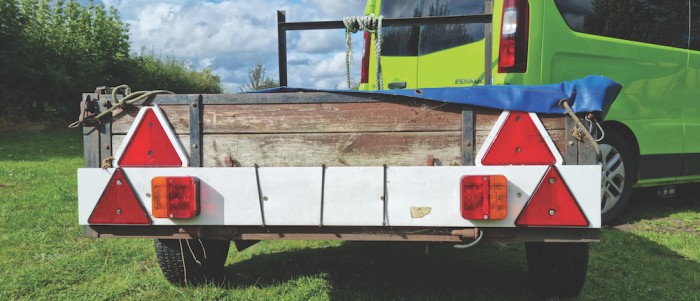
(Photo courtesy of Peter Rosenthal)
Reversing cameras and large mirrors are essential for towing and if you don’t have a rear camera, it’s well worth investing in one to make your life easier, increase safety and make it a doddle to reverse up to the trailer hitch.
With all towbar-mounted racks and trailers you’ll need to display your motorhome’s number plate to the rear. Motor factors, motorhome dealers and Halfords branches can make up a new rear number plate for you, but you will need to show your vehicle’s V5C logbook first.
Trailers must display reflective triangles on the rear edges of them and this also applies to cars being towed on an A-frame (the combination of car and A-frame is legally viewed as a trailer) where the easiest thing to do is to add a rear trailer lighting board.
Buying Your Perfect Motorhome 2024
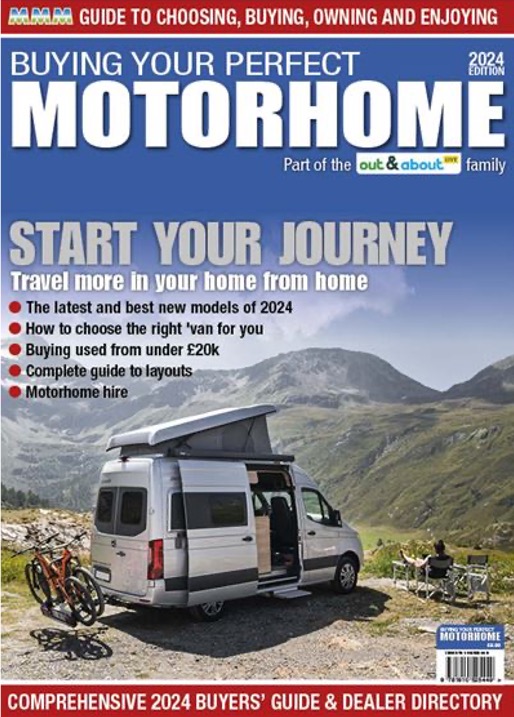
Looking for more great motorhome and campervan buying information? You need the brand-new guide to Buying Your Perfect Motorhome, it’s packed with everything you need to help you with choosing, buying, owning and enjoying your very first motorhome or campervan.
Learn more about it here.
Digital Download it now from Pocketmags for just £9.99.
Printed Or order a printed edition for just £9.99.
Expert motorhome advice to your door!
Why not subscribe to one of our fabulous magazines and get expert advice, travel ideas, technical help and all the latest news for your motorhome and your motorhome adventures!

Want to know more about MMM magazine?
Every month MMM has articles written by motorhomers who have been there and done it, from great UK and European (and further afield) tours, campsite reviews, owners' reports and DIY projects among other things.
MMM's tests, reviews and expert buying guides are not to be missed. MMM's technical advice is a must and includes everything from weekend jobs to longer-term DIY projects. And much more!
About MMM magazine
Want to know more about What Motorhome magazine?
Every issue of What Motorhome magazine provides essential buying advice for anyone looking to buy a new motorhome or campervan or upgrade their existing model. With a pedigree of over 30 years of offering the best motorhome and campervan buying advice, every issue of What Motorhome includes more new motorhome and campervan reviews than you will find in any other magazine.
About What Motorhome
Want to know more about Campervan magazine?
Campervan is the exciting monthly magazine that will give you all the inspiration you need to explore the world in your campervan. Every issue is packed with real-life campervanning experiences, inspiring travel ideas in the UK and further afield, the best campsites to stay on, campervan road tests and reviews of the latest models, and much more!
About Campervan magazine







Recent Updates
Where and how to sell my motorhome: the ultimate guide
Whatever your reason for selling, there are a number of steps to take to try to get the best price for your motorhome or campervan
Gas tanks or refillable cylinders: our guide to motorhome gas
From cooking dinner to the central heating, gas is an essential feature of motorhoming – here, we explore ...
Engine management lights: all you need to know
What is the engine management light? What does it mean, and what do I have to do? ...
Motorhome air suspension: all you need to know
Motorhomes are heavy and the additional weight of equipment and height of the bodywork can increase the loads ...
Motorhome WiFi: how to get better motorhome internet
Staying connected on the move is more and more essential, so relying on campsite WiFi isn't an option – here ...
A class of their own - our guide to A-class motorhomes
Thinking of trading up to an A-class, or even going straight to the top of the motorhome tree? We guide you ...
Explore overseas on a motorhome dream tour
Enjoy exotic travel in a campervan or motorhome by hiring, swapping with someone else or exporting your ...
Motorhome water systems: everything you need to know
On-board water is an important part of every motorhome – here’s everything you need to know ...
Campervanning in Europe: what you need to know
Whether you're planning a leisurely drive through the French countryside, navigating bustling city streets in ...
Campervan security: all you need to know
With thefts on the increase, it’s important to know how to keep your campervan secure and prevent campervan ...
Other Articles
Campervan furniture: everything you need to know
Our campervan experts guide you through all the essentials for your campervan, including tables, chairs, inflatable seating, windbreaks and ...
Campervan finance: how to fund your purchase
Here we look at the different types of campervan finance available, to help you decide what’s the best option ...
Britain’s best used motorhomes
Want a great motorhome without paying the premium for a new one? Here's a guide to the best you can get in ...
Which motorhome? Choosing the perfect motorhome for you
Choosing a motorhome or campervan is one of the biggest buying decisions you’ll ever make, so it's important ...
Campervan washroom essentials: stay fresh on the road
Our guide will take you through the campervan washroom essentials you'll need so you're well-prepared for ...
Dogs in campervans: all you need to know
Follow our advice and your dog will enjoy campervanning as much as you do ...
Electric campervans: all you need to know
Our guide will take you through everything you need to know about electric campervans and what the future ...
Motorhome electrics: a complete guide to your motorhome electrical set-up
Motorhome electrics can dramatically enhance the convenience and comfort of your vehicle – but they can be ...
Lighting for campervans: all you need to know
We guide you through all the lighting options available for you and your campervan, including interior ...
Electric bikes for motorhomes: our ultimate guide
Read our comprehensive guide to electric bikes for motorhome owners, helping you add electric power to your ...